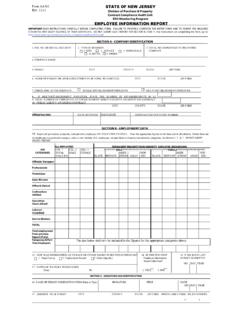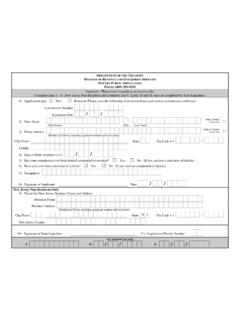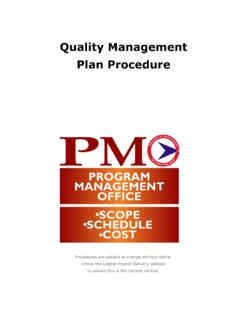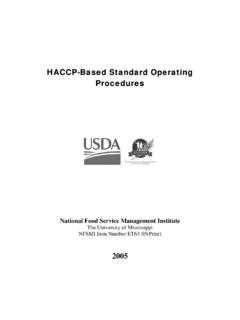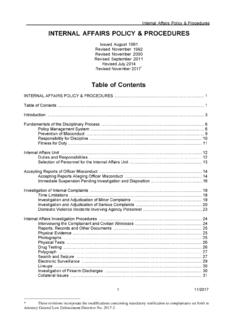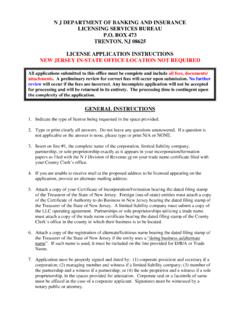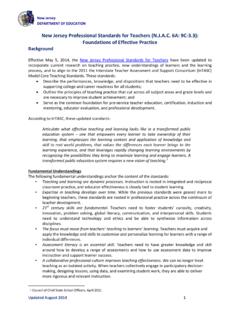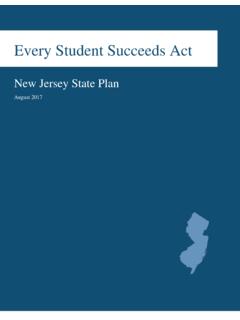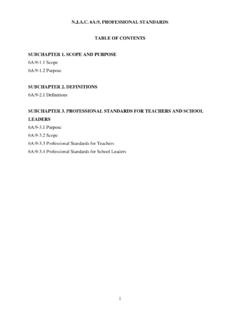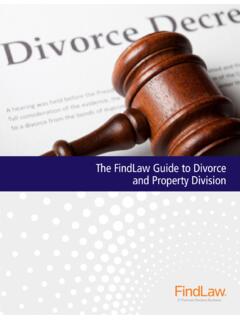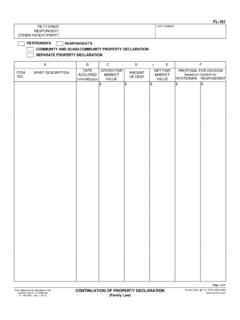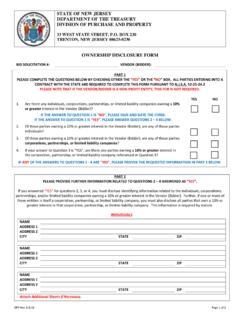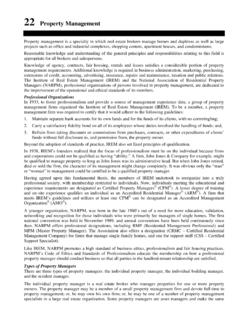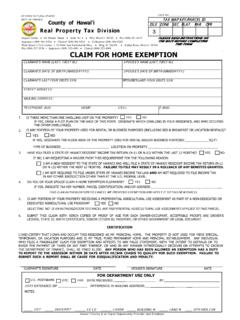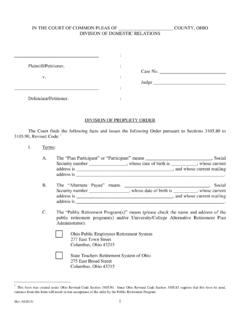Transcription of STANDARDS FOR VALUING PROPERTY COMMON LEVEL …
1 STANDARDS FOR VALUING PROPERTY New Jersey s real PROPERTY tax is ad valorem or a tax according to the value meaning that each person pays tax based on the value of the PROPERTY he or she owns. The State Constitution at Article VIII, Section 1, Paragraph 1 requires, PROPERTY to be assessed for taxation by general laws and uniform rules and that all real PROPERTY , except for agricultural/horticultural land*, must be assessed according to the same standard of value. New Jersey statute 54 defines the standard of value as the true value of PROPERTY . 54:4-23 describes true value as the price at which, in the assessor s judgment, each parcel of real PROPERTY would sell for at a fair and bona fide sale by private contract on October 1 next preceding the date on which the assessor shall complete his New Jersey courts have determined full and fair value, market value, and true value to be synonymous.
2 Taxable assessed value is that percentage of true value established by each county board of taxation. All 21 counties in New Jersey have chosen 100%. *Qualified Farmland is assessed on its productivity and agricultural use rather than market value for any other purpose. TRUE MARKET VALUE Market value may be defined as, The most probable price in terms of cash or cash equivalency which a PROPERTY will bring in a competitive and open market under all conditions requisite to a fair sale, the buyer and seller, each acting prudently, knowledgeably and assuming the price is not affected by undue stimulus.
3 Implicit in this definition is the consummation of a sale as of a specified date and the passing of title from seller to buyer under conditions whereby: Buyer and seller are typically motivated. Both parties are well informed or well advised, each acting in what he/she considers his/her own best interest. A reasonable time is allowed for exposure in the open market. Payment is made in cash or its equivalent. Financing, if any, is on terms generally available in the community at the specified date and typical for the PROPERTY type in its locale. The price represents a normal consideration for the PROPERTY sold unaffected by special financing amounts and/or terms, services, fees, costs or credits incurred in the transaction.
4 Market price means the amount actually paid for a PROPERTY in a particular transaction. The actual price one pays for a PROPERTY on the market is not necessarily representative of that PROPERTY s true value in the real estate market. An individual sale may deviate from the market norm but numbers of comparable sales show patterns or trends in value. These value trends help to identify market value. Although market value can be subject to sudden fluctuations, in general true value for PROPERTY tax assessment purposes must be fairly constant and measured by conditions which, over time, are regarded as stable.
5 Market or sale price, while a factor in determining the market value of a PROPERTY , is only one consideration. TRENDS AND FACTORS In assessing real PROPERTY for local tax purposes, all available evidences of value are taken into account. Trends and factors affecting PROPERTY value which an assessor or appraiser consider are: The economy purchasing power, wage levels, employment rates, inflation, recession, housing shortages/surpluses, construction costs for materials and labors, interest/mortgage rates; Government public services as police/fire protection, zoning ordinances, building codes, taxes assessed; Environment, geography and location weather conditions, soil types, waterways, the surrounding neighborhood, proximity to schools, churches, stores, transportation.
6 Physical characteristics of surrounding properties, comparable properties and the subject PROPERTY in terms of construction quality, age, maintenance LEVEL , depreciation, architectural style, lot size or acreage. TAXABLE ASSESSED VALUE An assessment is an opinion of value by a licensed professional. All municipal assessors must pass a 6-hour certification exam in PROPERTY appraisal and PROPERTY tax administration. 54:4-35 requires the assessor to determine his taxable valuations of real PROPERTY as of October 1 in each (pretax) year. The New Jersey Supreme Court has ruled that, Each annual assessment of PROPERTY for tax purposes is separate and distinct from the assessment for any other year.
7 COMMON LEVEL RANGE Despite the true value requirement of the law, the courts have ruled that no PROPERTY may be assessed at a ratio to true value which is above the COMMON LEVEL or average ratio of all assessments in a taxing district. A COMMON LEVEL range is permitted and is calculated at 15% above to 15% below the COMMON LEVEL or average ratio. During an appeal, once the hearing body determines the true value, the taxable or assessed value of the PROPERTY is divided by its true value to develop the subject PROPERTY ratio. If a PROPERTY s ratio of assessed value to true value falls outside the COMMON LEVEL range, its assessment is adjusted by applying the average ratio to its true value.
8 METHODS OF VALUING PROPERTY Various methods are available for appraising or VALUING PROPERTY . Selection of the proper method depends on the nature of the PROPERTY and purpose for which the appraisal is made. In appraising real PROPERTY for taxation, the appraisal must be made in accordance with the basis of real PROPERTY value recognized by State law, as interpreted by the courts. Numerous judicial decisions recognize the validity of 3 methods for estimating PROPERTY value for tax purposes. The cost of replacement, the market data or sales comparison, and the income approaches to value are used to estimate PROPERTY value and are given appropriate weight.
9 The Replacement Cost Approach (commonly used for new construction) estimates the cost of creating a building with the same or equivalent utility as a similarly developed PROPERTY , as nearly as current prices and STANDARDS of material and design allow. An amount is deducted for wear and tear and age (depreciation.) This approach is based on cost per square foot as related to the quality of building materials and workmanship. The land value is added to the depreciated cost of improvements to get the total PROPERTY value. The Sales Comparison Approach attempts to find market value through a comparison of the subject PROPERTY with similar properties which have been sold for a known sum of money.
10 The number and size of rooms, quality of materials and workmanship, the PROPERTY s physical condition and location, and time of the sale are considered with this approach. The Income Approach analyzes the future income stream produced by a PROPERTY to estimate the sum which might be invested to purchase the PROPERTY in order to receive future benefits. Whenever possible, all three approaches should be used in the valuation of every PROPERTY . However, one approach may be more relevant than another and have more weight in the valuation process. REVALUATION, REASSESSMENT AND COMPLIANCE PLANS The need for revaluation/reassessment may be shown by any evidence which indicates properties in a taxing district are not assessed at the same rate of true value.
